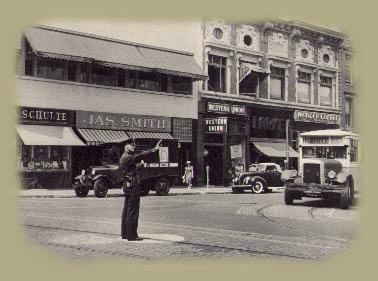|
|

Remembering 9-11-01.
We will not forget!
|

|
 |
The Traffic Squad
Badges of an old California Speed Cop
|

Sergeant Henry O'Banion figures ya need to
learn how to drive....
The following photographs represent a
collection of badges and memorabilia belonging to Justin W. "Wally"
Cheshire, born October 25, 1901 in Grants Pass, Oregon. His father, Samuel F.
Cheshire, was the elected County Clerk of Josephine County. They moved to
Pasadena, California in 1914. When World War One started, Wally joined the Army
in 1917. He was only sixteen but he lied about his age. He joined the American
Expeditionary Force in France, and was wounded in the battle of the Argonne
Forest in 1917.
After returning home to Pasadena, he joined the Pasadena Police Force as a
"speed cop", riding his own motorcycle that he leased back to the
City. In the 1920's, he left Pasadena PD and joined the Los Angeles County
motorcycle patrol.
When the California Highway Patrol was formed in the early 1930's, he was
selected to be a part of this newly formed service. His badge number was #500,
assigned to the Bay Bridge and later teaching at the Highway Patrol Academy. He
retired medically in 1939 at an early age due to disabilities he received while
riding motorcycles and from his war wounds. He passed away in 1959.
|
Click on the
thumbnail

|
A young Wally Cheshire poses alongside
his bike during his early career days in Pasadena. The badge he's
wearing is the one shown below. |
|
|
 |
This custom-die badge, number 29, from
Pasadena was Cheshire's first badge as he began to patrol the streets of
the Southern California city, circa 1917. The custom City Seal and the
eagle are gilt, while the remainder is nickel plate. The lettering,
except the badge number, is raised and can be read from the back as
well. This is a real work of art from Chipron in Los Angeles.... my
favorite out of all of them. |
|
|
 |
The matching hat badge from Pasadena
was this simple wreath with the applied "Police" across the
center. Very typical for the era, this badge has loops for attaching to
the hat. |
|
|
 |
In the 1920's, the State of California
had no Highway Patrol, so the counties provided "Motor Police"
to enforce traffic laws. While the State paid the motor cops salaries,
they actually worked for the county. Los Angeles County was no
different. Cheshire left Pasadena and joined the ranks of Motor Police
for LA County, being assigned badge number 25. This beautiful bear-top
shield is a good example of the era's California-style badge. It's gilt
with hard blue enameling. |
|
|
 |
The matching hat badge worn by Cheshire
was this gilt "flying wheel". |
|
|
 |
Wally Cheshire poses on his bike while patrolling for LA
County and wearing the above badges. |
|
|
 |
Wally Cheshire poses with his LA County
bike at the Pasadena Substation just before joining the newly formed
CHP. At 6'2, 200 pounds, he was certainly a different figure from that
scrawny kid back in Pasadena. |
|
|

Wally Cheshire in his Army uniform before his career as a traffic
copper. |
In 1923, a California Supreme Court
decision made it illegal for counties to employ traffic officers which
led to the formation of the modern CHP. The CHP was finally formed on
August 14, 1929 and originally included 280 uniformed men, 80 cars and
225 motorcycles. The first Superintendent was Eugene W. Biscailuz who,
when he was appointed by the Governor, was the Undersheriff of Los
Angeles County. Wally Cheshire followed his Undersheriff to the newly
created agency. The early CHP officers were paid a salary of $170 per
month for a six day work week with no overtime pay and they had to
supply all of their own equipment. Today's officers are making over
$4,000 per month and have generous benefits. (My thanks
to collector John Yeaw, CHP (retired), for this background information
on CHP) |
|
|
 |
Cheshire used this CHP bumper tag,
number 157, on his car in an era when it was safe to let the rest of the
world know you were a cop. |
|
|
 |
CHP Patrolmen line up for inspection
during the 1930's at the Bay Bridge headquarters. "Speed cop"
Cheshire is the 3rd from the left. He loved to call himself that,
coining the phrase long before today's moniker. |
|
|
 |
Wally Cheshire retired with a medical
disability in 1939 and was presented this fine gold-filled retirement
piece made by Irvine & Jachens. After 22 years of riding motors,
vaulting automobile hoods and sliding down the pavement, Cheshire gave
up his bike. |
|
|
 |
Wally was proud of his badge number,
500, but when he retired, the State engraved his serial number, rather
than his badge number, on the back of his retirement badge. This
incensed Cheshire, to the point where he ground the serial number off.
His name can be seen engraved on the back. He carried this piece for the
next 20 years in a brown leather holder until his death in 1959. |
|
|
The
Station House, Police Badge Network, Copyright © 2011, Dave Arnold. All rights reserved. The photographs, graphics and data contained in this Web site are the properties of the contributors, Dave Arnold,
badgesource.com or copcar dot com and may not be used without expressed written consent.
|












